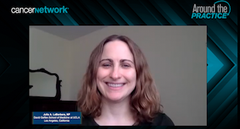
Shared Decision-Making and Treatment Sequencing in HER2+ MBC
The importance of forming partnerships with patients and understanding their preferences for therapy when establishing treatment algorithms for patients with HER2-positive metastatic breast cancer.
Episodes in this series

Sara A. Hurvitz, MD: Erika, I want to turn to you and talk to you about the decision to go on T-DM1, or trastuzumab emtansine, as your second-line therapy. When you were making this decision with your clinician, what things did you express as being important to you when going on your next line of therapy? Was it omitting that hair loss? Was it length of survival or progression-free survival? Was it your ability to travel? How did you have that conversation and participate in shared decision-making with your clinician?
Erika Rich: When it came to any kind of treatment, my No. 1 was hair loss. My least favorite thing about cancer was losing not only your hair but also my eyebrows. That was my No. 1, and [my doctor] knew that from the get-go. Whenever he would present new medicines to me, he would always preface it with that to let me know. It was dependent on what was going on with my cancer at the time. If the best option for me was to take the medicine that causes hair loss, but there also was this other option where I wouldn’t have the hair loss, he would be understanding in talking about adverse effects with everything and never pushed me to go 1 way or the other. For 1 treatment, I took it because there wasn’t any hair loss, but then I ended up having to take a medicine that did cause hair loss anyway. And I ended up not losing my hair at all. That was refreshing.
I was recently on a medicine where my counts weren’t affected, and I had the freedom to travel. I got a good taste of that in 2021. That’s been my focus with my oncologist: what am I going to do to be able to be gone for an entire month to do these kinds of excursions? What are we going to do if I do need to get my medicine and I’m traveling? My mom loves hearing me talk to him about this because she’s like, “You’re going to be the death of this man.” I was like, “He needs to figure this out because I’m sure other people would like to be able to do this as well.” I do get a little testy with him whenever he recommends things and I’m like, “No, that’s not going to work right now.”
Having so much recent progression, I understand the severity of having to take certain medicines. Right now I’m on a medicine that threw me out of my travel game, just to get everything stable. That way, I can look at other options. As you said, everything is adapting quickly. By the time I’m done with this medicine, there might be something new. When I had my brain metastases, tucatinib didn’t exist. That came out a few months later, and then I got on it and was able to give that a try. It is crazy how quickly these new medicines come out, which is why I’m grateful for my doctor having all these new things. In the past year I’ve done 3 or 4 different treatments. Each time I’m like, “This is my last option.” We start talking about looking into clinical trials. Whenever something else happens and we have to talk about a new medicine, all of a sudden I have 3 new options that I can pick from. It’s especially crazy because my family has never had to deal with this before. We’re just like, “Wow—science.”
Sara A. Hurvitz, MD: You bring up some great points. For this subtype of breast cancer, we’re seeing data from real-world registries. There was 1 published in France recently: 18 comprehensive cancer centers that participated in something called ESME [Epidemiological Strategy and Medical Economics]. It reported the median overall survival for a patient diagnosed in 2008 with HER2 [human epidermal growth factor receptor 2]–positive breast cancer through 2015 or ’16. The median survival has gone up every year by many months. Instead of a 3-year overall survival expected, we’re going beyond 4 or 5 years. It’s going to continue to rise given the changes in the way we approach this disease and the fact that the driver of the cancer has been identified.
Erika, you bring up a good point about sequencing and how important it is for us as clinicians. We can look at the mechanism of action and the data that inform our recommendations, but it’s important to talk to our patients about the adverse-effect profile and how it may impact quality of life by frequency of clinic visits and infusion room visits and the adverse effects that you mentioned—hair loss, nausea, and other GI [gastrointestinal] adverse effects. It’s truly a shared-decision process that helps us optimize how we sequence these therapies. Another feature is looking at whether a patient has active brain metastases or stable brain metastases. That helps guide our recommendations, but it’s always a partnership with our patients as you eloquently expressed.
Transcript edited for clarity.
Newsletter
Stay up to date on recent advances in the multidisciplinary approach to cancer.

















































































